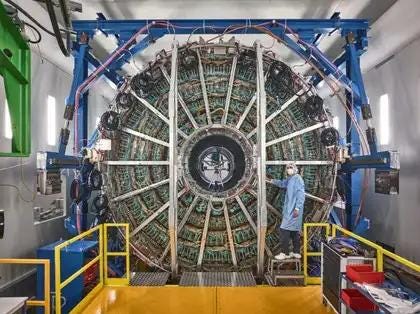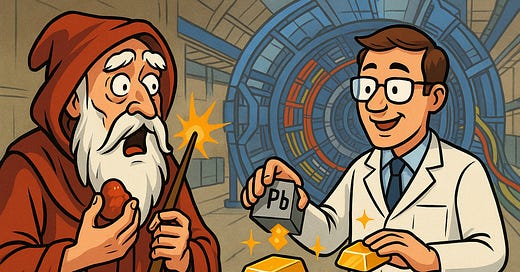Modern Alchemy Discovered—but it Ain’t Worth its Weight in Gold
CERN’s Modern Alchemy: The Transmutation of Lead into Gold at the Large Hadron Collider.

Modern Magic Unfolds: Alchemy Discovered
In a plot twist that would make even the most flamboyant medieval alchemist choke on his philosopher’s stone, scientists at CERN have pulled off the impossible: they’ve transmuted lead into gold. No incantations, no bubbling cauldrons—just the world’s most powerful particle accelerator and a few trillion euros’ worth of technology.
Before you dust off your family heirlooms to see what might be “upgraded,” hold your horses. This isn’t the start of a new gold rush—it’s more of a brilliant scientific side quest, where the payoff is intellectual, not financial. Still, it’s hard not to appreciate the cosmic irony: what ancient mystics spent lifetimes pursuing with mercury and dreams, modern physicists accomplished in an afternoon—underground, with lasers.
The Alchemist’s Obsession Meets the Physicist’s Precision
The transmutation of base metals into gold was the central obsession of alchemy, a mystical forerunner to chemistry that spanned cultures and centuries. From Chinese Taoists to Arab scholars and European visionaries, the philosopher’s stone was believed to hold the power to transform the ordinary into the extraordinary. Yet these efforts, however sincere or deluded, were doomed by a fatal misunderstanding of atomic structure.
We now know that the essence of an element lies in its nucleus—specifically, the number of protons it contains. Lead has 82; gold has 79. No chemical manipulation can change that. Only nuclear physics, a field utterly foreign to the ancient alchemists, holds the key to changing one element into another.
Deep Underground: Where the Magic Really Happens
At the forefront of this nuclear artistry is CERN, the European Organisation for Nuclear Research, straddling the Franco-Swiss border near Geneva. Beneath the soil lies the Large Hadron Collider (LHC), a 27-kilometre circular tunnel filled with superconducting magnets and high-tech detectors.
The reason the LHC is buried up to 175 metres underground is not secrecy or science fiction flair, but necessity. The Earth serves as a protective shield, blocking out cosmic rays—high-energy particles from space that would otherwise interfere with the sensitive instruments needed for particle detection. By isolating the LHC from these disturbances, scientists ensure the clarity and reliability of their data.
The Process: Gold, Born of Photonic Ballet
The transmutation took place during the LHC’s heavy ion runs, using the ALICE (A Large Ion Collider Experiment) detector. In these sessions, lead nuclei are accelerated to nearly light-speed and made to skim past one another in so-called ultra-peripheral collisions. These near misses generate incredibly strong electromagnetic fields, unleashing high-energy photons in the process.
These photons can interact with the nuclei, knocking out three protons in a mechanism known as electromagnetic dissociation. With three protons gone, lead (82) becomes gold (79). Alongside gold, other elements such as thallium and mercury also emerge briefly, thanks to similar interactions.
The ALICE detector, particularly through its zero degree calorimeters, was able to detect and analyse these fleeting transformations with remarkable precision.
The Scale: Gold Dust in the Most Literal Sense
As extraordinary as the process is, it is not remotely scalable in economic terms. The amount of gold created—29 picograms—is unimaginably small. That’s 29 trillionths of a gram, or roughly what might settle on a desk over a year in the form of dust. Moreover, these gold nuclei are inherently unstable, vanishing in less than a blink.
The cost of this transformation, when accounting for energy, infrastructure, and time, is staggeringly higher than the value of the resulting gold. As such, the experiment is a scientific curiosity, not a commercial enterprise.
The Real Treasure: Knowledge, Not Karats
What makes this milestone truly golden is its contribution to our understanding of fundamental physics. The experiment is a compelling demonstration of nuclear alchemy, achieved through pure scientific reasoning and advanced technology.
By manipulating atomic structures, scientists continue to unlock insights into the building blocks of matter. The implications extend to nuclear medicine, advanced materials, and even our grasp of how elements are formed in the hearts of stars. While not financially lucrative, the knowledge acquired is profoundly valuable.
Back to the Cauldron—Sort Of
So, no, the modern physicist won’t be driving off in a gold-plated Tesla anytime soon. But if ancient alchemists could witness this feat, their eyes would widen—not from envy, but wonder. The philosopher’s stone wasn’t a rock after all. It was curiosity, mathematics, and a budget that could fund a small country.
In the end, the real magic lies not in the gold itself, but in the sheer audacity of asking the impossible question—and building a 27-kilometre machine just to find the answer.
In summary: “None of my CON_CERNs”
”CERN may not have minted millionaires, but it’s done something arguably better—it’s reminded us that the pursuit of knowledge, no matter how eccentric it may seem, can still spin scientific gold from the most unpromising of elements.’ #KBSOriginal





In summary: “None of my CON_CERNs”
”CERN may not have minted millionaires, but it’s done something arguably better—it’s reminded us that the pursuit of knowledge, no matter how eccentric it may seem, can still spin scientific gold from the most unpromising of elements.’ #KBSOriginal
That’s really good. 👍